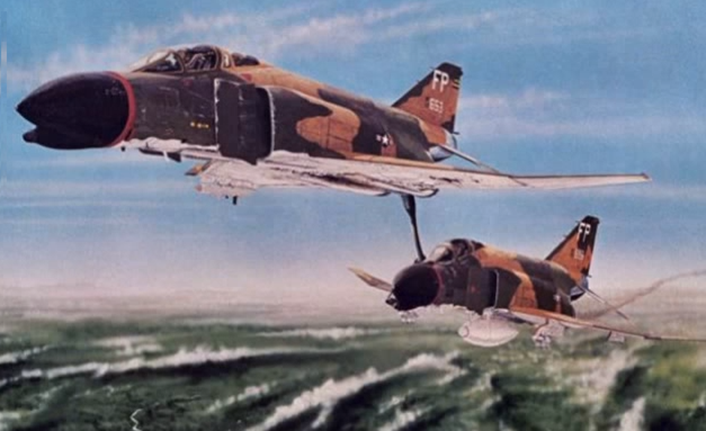
The famous episode when a USAF F-4 pushed another Phantom outside North Vietnam airspace.
Developed as interceptor in response to the need of the U.S. Navy to protect its aircraft carriers, in 1963 the U.S. Air Force procured its version of the McDonnell F-4 Phantom II, designated as F-110A and almost immediately redesignated as F-4C. 583 F-4Cs were built and employed in Vietnam where they fought against MiGs and intense ground fire.
Nevertheless the Phantom proved to be a very robust airframe, a claim confirmed by one of the most impressive stories of the conflict, known today as the “Pardo’s Push.”
As told by John L. Frisbee in his 1996 article for Air Force Magazine and today available on worldaffairsboard.com, among the 132 sorties that the Retired Lt. Col. Bob Pardo flew in Vietnam with the 8th Tactical Fighter Wing, the most memorable mission is for sure the one that took place on Mar. 10, 1967, when he and his Weapon System Officer (WSO), Lt. Steve Wayne, attacked a steel mills near Hanoi.
The Phantom flown by Capt. Earl Aman and Lt. Bob Houghton Phantom was also part of the mission. Over Hanoi, Captain Aman’s F-4 was hit. He was able to stay with the formation, but Aman was hit again before reaching the target and his Phantom began to leak fuel rapidly.
Pardo’s Phantom was also hit but he was able to continue with the strike, even though his F-4 was leaking fuel too. On their way out, at 20,000 feet, it became obvious that Aman and Houghton would have never reached Laos (where they could have ejected safely and avoid an almost certain capture).
Pardo had enough fuel to reach a tanker, but he never thought to leave Aman and Houghton to an uncertain fate: Pardo decided to stay with Aman as long as he could.
But while they were still over North Vietnam, Aman’s F-4 flamed out.
To save Aman and Houghton, Pardo decided to do something that (he thought) had not been done before. He would have pushed Aman’s F-4 to Laos (but as explained by Frisbee, in 1952, during the Korean War fighter ace Robbie Risner had pushed his wingman out of North Korea in an F-86. Pilots then were ordered to refrain from attempting the hazardous act again, and the event, which Risner hardly ever mentioned, faded from memory).
So with a delicate touch, Pardo brought the nose of his Phantom into contact with Aman’s F-4, but he soon discovered that the nose of an F-4 was not designed for pushing another aircraft.
After several failed attempts, Pardo came out with an extreme solution.
After having told Aman to lower his tailhook, Pardo leaned his windscreen against the tailhook of the other Phatom. Even if his idea worked, Pardo continued to lose contact because of turbulence and he had to reposition every 10 or 15 seconds.
Pardo also experienced a fire in one of his own engines and was forced to shut it down. In the remaining 10 minutes of flight time, Pardo used the one remaining engine to slow the descent of both planes. Pardo’s plane ran out of fuel after pushing Aman’s F-4 almost 88 miles; when both planes reached Laotian airspace, at an altitude of 6,000 feet, both aircrews ejected.

Fortunately, all four men escaped capture and were rescued by a helicopter that brought them to Udorn Royal Thai Air Base, Thailand.
According to Frisbee, Bob Pardo was an instant hero to the other pilots but not to some “higher-echelon accountants,” who threatened to bring charges against him for losing an expensive airplane. Good judgment prevailed, and the charges were dropped, but his achievement was rewarded only in 1989, more than two decades later, when Pardo and Steve Wayne received the Silver Star for what came to be known as Pardo’s Push.
The following video explains how the famous Pardo’s push not only saved the lives of Earl Aman and his WSO Bob Houghton, but also contributed to prove the extreme strength of the Phantom airframe.



